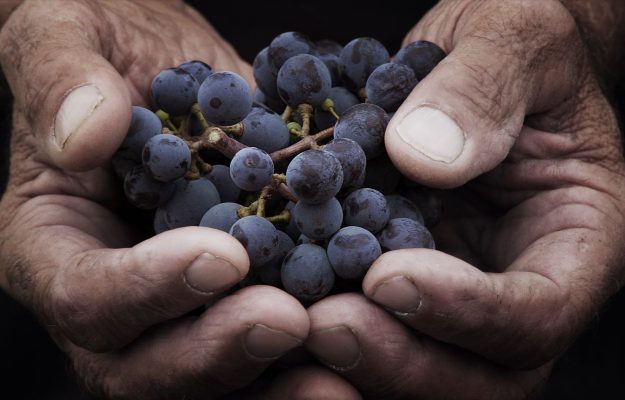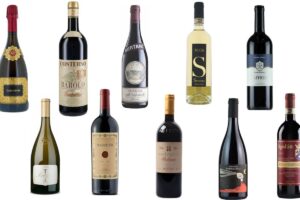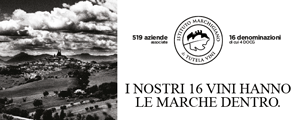The first bunches of grapes arrived in the cellars a few weeks ago, and the harvest is now getting into full swing in every region of Italy, with a confirmation of the production drop expected a few months ago: the national production of wine for 2021 campaign will stand at 44.5 million hectoliters, down 9% compared to 49 million hectoliters of 2020, as revealed by the data processed by UIV - Unione Italiana Vini, Assoenologi and Ismea, presented today. As always, this result is, at the moment, the average of a range which oscillates between a minimum of 43.7 and a maximum of 45.3 million hectoliters, but the weather conditions of the next weeks will be crucial to better define the productive scenario. It will be, in fact, a vintage of great apprehension because of the persistent climatic changes and of a very uncertain weather trend, which can also create important qualitative and quantitative differences in the neighboring areas, after a season characterized by spring frosts, which affected many areas, especially in the Center-North, followed by a particularly hot and dry summer where there were strong storms, accompanied by important hailstorms.
Quantitative estimates are referred to the situation found in the last ten days of August, that is when almost all grapes were still on the plants. If September and October will run positively, the estimates here reported could be confirmed. Veneto, according to the first data collected, keeps the leadership and consolidates itself as the most productive Italian region with almost 11 million hectoliters, followed by Apulia (8.5 million hectoliters), Emilia Romagna (6.7 million hectoliters) and Sicily (3.9 million hectoliters). These four Regions together in 2021 will produce 26 million hectoliters, that is 60% of all Italian wine.
Taking stock of the situation, which also looks beyond national borders, is the president of Assoenologi Riccardo Cotarella, who sees in precision viticulture the only credible answer to climate change, and in the drop in production not necessarily a drama. “The drop in production in France is not surprising, in addition to frost and drought, especially in the Médoc, as is that of Italy, while the drops in Germany and Portugal are not incisive. Climate change, in this sense, has an enormous influence, much more than Covid. The year 2021 spared us nothing: frost, hail, drought, storms. The answer lies in precision viticulture, in which cognitive science is applied in the vineyard: there is no longer room for improvised viticulture. Some autochthonous vines, about 90%, if brought to production with a scientific training system, give exceptional results. In this sense, climate change may not be so devastating, as long as we apply existing technologies by working in the vineyard, not in front of a computer, we must be precise, punctual, passionate. Low production - continues Riccardo Cotarella - does not penalize everyone: it weighs on those who produce important DOPs and requested on the market, but not everything is for the worse. A year ago, the world record in production did not help much, if not to sell off common wines below cost. I hope this decrease will revalue grape prices. It is to be hoped that it is not an excessive drop for certain denominations, but let’s take advantage to try to get a minimum of moral and economic revaluation, as happened in 2017, it is an opportunity to be seized. As far as quality is concerned - concludes the Assoenologi president - it will be very heterogeneous. In Italy, we have areas where we will still make excellent wines, with territories where the grapes are really good, but certainly the work of individual companies is fundamental, in the vineyard as in the cellar. On average, it will be a good vintage, if not very good, with some exceptional peaks. Besides the euphoria of the moment of this return to normality, let’s remember wine is life: when things go well, wine goes well as well. There is, basically, optimism, let’s hope the ones who decide our destiny will be benevolent, because two years of the pandemic are more than enough, always remembering we are among the wine sectors which have the least to complain”.
The harvest, the real beginning of the wine year, is, however, also the right time to take stock of this past year and line up the priorities that the supply chain will have to face, as the president of Unione Italia Vini (Uiv) Ernesto Abbona does. “This moment marks the starting point of the wine calendar, it's as if a child were born, and it offers an opportunity for the sector to reflect on its state of health, programmatic lines and future policies. We think about producing, but we also need to sell what we produce and defend ourselves from outside aggression. It would be nice if this moment marked the turning point between the pandemic and a tomorrow to be built. I would like to remind you, however, that these are forecasts, subject to variability, but this is the most precise data we can offer. It has been a bizarre vintage, which gives us a harvest that nevertheless preserves an excellent quality, in almost all the territories of our country. The weather has not always helped us, but excellence in the vineyard, today, is achieved with experience, professionalism, commitment, good practices and techniques of precision viticulture, which make all the difference in the world, because they allow not to suffer the damage that until a few years ago was inevitable. It can be the vintage of the revival, because despite the drop in production Italy is confirmed as the world leader, so we can reaffirm our leadership in the markets, achieved in 2019. The signals, in this sense, are encouraging, even over two years ago, and this means that our companies have been able to create value. Signs of strong growth are recorded on all the main markets, from the USA to Canada, from Switzerland to Japan, from Russia to China, where there is an extraordinary opportunity for growth after the ban on Australian wines. All this - continues Ernesto Abbona - must spur us to do more and more and better. With an enormous challenge: to transfer the rising cost of grapes to the markets, because labor is increasingly specialized, but it costs money, as does technology. In this sense, it is necessary to think of professional schools to train the workers of tomorrow, so that they arrive at the company already trained. For all of this, the country needs to move together under a single direction, hoping for governmental stability so that we don't have to start over every time with a new minister. We appreciate the efforts made on the promotion front - underlines the president of the Unione Italiana Vini (UIV) - but on the Ocm Promozione announcement we ask for more flexible timeframes for the presentation of projects, and an increase to 60% of the European contribution. We want to respect the anti-Covid protocols, even if they have costs and sometimes complicated management. The 25 million euros for the institutional promotion of wine is a good thing: it is necessary, and must lead to a strengthening of the Italy of wine also in the field of wine tourism, provided that diversity is told and respected. We hope that companies will be involved in these actions, with respect to the markets to be privileged and the media to be used: we want to be involved, we cannot be passive spectators, precisely because they are public resources, which must be addressed in the best possible way. Sustainability is a very important issue: Minister Patuanelli has promised an acceleration on the single standard, but we are in the nick of time and we want to achieve this goal in time (end of September). Uniforming, with a single logo, this effort is very important, so we urge the Ministry to define a clear road map towards a regulation that would allow us to benefit from a competitive advantage over other countries, we would be the first to have a single standard. It would be extremely important for small and medium-sized companies, which could undertake training courses on a standard that is fundamental for growth abroad. Respect for deadlines, I repeat, is fundamental”, concludes Ernesto Abbona.
To answer, indirectly, to the stimuli of the president of Unione Italiana Vini (Uiv), is Gian Marco Centinaio, Undersecretary of Agriculture with delegation to wine. “The wine sector continues to be a driving force for the agricultural world, as it has always been, also in light of a recovery we are experiencing since we have returned to a certain degree of normality and sociality, which is needed by those who work in the Horeca channel. As a Ministry, we want to continue along the path of recent months, and so after Vinitaly and MilanoWineWeek there will be a meeting of the Wine Table to take stock of the harvest and these two events. We have accelerated the game of Ocm Vino, with some controversy from some regions, perhaps even partly understandable, but we had to go quickly. We are willing to review our mistakes to improve. For promotion we have allocated another 25 million euros, I think we need them to address emerging markets, where we try to face our competitors. We will discuss - adds Centinaio - with the wine world to understand how to spend them, to take on board the observations of those who are in the field, which are essential to bring home the result. On the promotion game we are in line with our expectations. On the Sustainability Decree, we are open to improvements. Another important topic is wine tourism, with the trade associations that have asked for the opening of a dedicated working table, which we would like to open quickly, because we are already late. And then, there is the important question of relations with Europe: we have to work as a team, I still have in my head the controversy about alcohol-free wine and the attempts to pass off wine consumption as highly carcinogenic, and I still think that at a scientific and communication level, we have to put ourselves in a position to speak with one voice, to prevent wine consumption from being seen as an absolute evil. One of the points on the agenda of the next table of the supply chain - concludes the Undersecretary for Agricultural Policies - must be this: to work with Italian parliamentarians in Europe to get these concepts across. There are still many games to be played, in order to relaunch the sector and give it continuity; we will play them with a spirit of collaboration and openness, hoping that growth will continue into autumn and winter, without any more hiccups or closures, and this is a fundamental task for politics, which must guarantee continuity to the companies in each sector”.
In the European context, fundamental support to the Italian wine sector will come from Luigi Moio, Professor of Enology in the Department of Agriculture of the University of Naples Federico II and new president of OIV - International Organization of Vine and Wine. “First of all, I want to thank the support of Government for my candidacy for the presidency of OIV. An almost natural candidacy, the final act of a journey that began in 1998, as a scientific expert at the Ministry of Agriculture, making a fundamental contribution to the drafting of numerous resolutions”, says Luigi Moio. “I am familiar with the functioning of the OIV, a body of scientific reference and harmonization of the wine supply chain at a global level, which must expand to other member states, favoring inclusion to spread the culture of wine in new areas. In this three-year period, which leads to the centenary of the OIV, the weight and the role of Italy are of strategic importance, in full harmony with France, in the wake of a broad and fruitful discussion with scientific experts, focusing on sustainability, the environmental impact of viticulture, global trade, complex issues. There is a lot of talk about climate change, but it is a complex issue, which requires a long time, and does not allow for mistakes, it requires very high skills and knowledge, any error lengthens the timeframe. Another important aspect - continues the president of OIV - is the evolution of the global market, which must aim at facilitating wine exchanges as much as possible, and it will be even more important at the end of the pandemic. All this while respecting the history and tradition of member states: wine is a fundamental economic driver, because it tells landscapes, stories and culture, making it a unique tourist attraction. In addition to the traditional activity of OIV, labeling, new methods of tracking analysis, today more than ever it is necessary to address an important point: knowing how to communicate to young people, because wine is different from any other beverage, alcohol is a fundamental component, but the educational and pedagogical power of wine is enormous, it combines nature, history and culture, and we must not stop teaching it to those who attack wine, which has nothing to do with any other alcoholic beverage. Italian wine can count on all my commitment and on my role so that Italy can continue to play a prominent role in the worldwide wine scene”, concludes professor Luigi Moio.
Returning to the contents of the harvest report by Unione Italiana Vini (UIV), Assoenologi and Ismea, “in a complicated phase, the start of this campaign seems to meet, in terms of quality and quantity, the needs of the sector”, explains Fabio Del Bravo, head of Ismea’s Rural Development Services Department. “The eyes are on the demand, because the domestic one in 2020 saw a +7% of sales in the Gdo, in the first 8 months of 2021 bring us back to normal dynamics, with wine that makes +2.3% in Gdo. Exports, after -2.3% in 2021, are experiencing a greater reaction compared to the agro-food sector (+11% vs. +10%): exports reward higher quality products, therefore DOP and IGP, while ordinary wines are penalized. The first estimates of this harvesting campaign, indicate a production of 44.5 million hectoliters (-9% compared to 2020), but these are numbers estimated on a normal course, in the hope there will be no setbacks, and they are then average values, ranging between 43.7 and 45.5 million hectoliters. At a territorial level - continues Del Bravo - we can read a drop of -12% in the North and in the Center, with frosts that have affected in a similar way, while the South registers a -5%, with Sicily, Calabria and Campania registering a growth. In regional detail, the decline affects all the main production regions, but with different relevance, from -7% in Veneto to -25% in Tuscany. It is likely that Italy’s productive supremacy, in the end, will remain, despite the minus sign”.
The problems connected to the more and more changeable and unpredictable weather conditions require more careful monitoring by winemakers and enologists, with particular attention to custody and environmental sustainability, elements which are now necessary also for adequate recognition by consumers. Such a production level, however, allows Italy to remain the world’s leader in front of Spain and France: the first one is not expected to exceed 40 million hectoliters, whereas the second one is suffering from a particularly adverse climate trend starting from the intense spring frosts This production campaign, moreover, comes in a very important moment for the sector which, after the problems linked to the pandemic, can start looking at the future with more optimism, thanks to the reopening of the Horeca, the recovery of tourism and a good rhythm of deliveries beyond national borders.
In terms of the various geographical areas of the country, there has been a rather general decline, with very few exceptions, but with different degrees of intensity. Starting from the Northwest, decreases of around 10% are estimated for Piedmont and Liguria, while in Lombardy the losses appear to be 20%. On the other hand, losses are limited in Valle d’Aosta. Moving on to the Northeast, there have been more limited reductions in Veneto and Friuli Venezia Giulia (-7%), compared with -10% in Trentino Alto Adige and -15% in Emilia Romagna. In Central Italy, the drop in Tuscany (-25%), hard hit by the April frosts, seems to be particularly important, with the other neighboring regions, however, showing significant losses, starting from -18% in Umbria, accompanied by -13% in Marche and -10% in Lazio. In the South, the situation is more varied, with Sicily, Calabria and Campania even reporting increases in production, while the reduction in Apulia is decidedly contained and below the national average and that of Abruzzo stands at -18%. Molise and Sardinia, on the other hand, recorded -15%, while the drop in Basilicata stopped at -10%.
“The climatic trend of the Italian vineyard - says Paolo Brogioni, director of Assoenologi - tells about a vintage characterized by extremely variable events, with peaks of high and low temperatures, while on the water front the resources accumulated in autumn and winter, with the spring rainfall, were sufficient. A disrupted beginning of the year and a small rise in temperatures at the end of February. The situation reversed in March, with an end of month that led to the frosts of April 7 and 8, which involved all regions of the North and Center. In May, rainfall was not quantitative, but intense, with thunderstorms, as in June, where the anticyclone was not immediately established. In July and August, similar trend, with the summer anticyclone more to the south of the Mediterranean basin than usual, characterizing a rise in temperatures and some water suffering in the South and Center, while in the North has maintained a substantial average temperature. The heat wave, from August 9 to 16 was anomalous and above average: it should be noted that the rain was often accompanied by hail in different areas of the Center and the North. As mentioned - continues Paolo Brogioni - the maximum temperatures were particularly high in the North West, the Centre and the South of Italy, with minimums all in all in the norm. From the point of view of rainfall intensity high and above average in Lombardy and Emilia Romagna. Particular attention should be paid to the vegetative trend, which was normal but interrupted by the April frosts, with evident damage in Tuscany, Umbria and the north of Sardinia, with a drastic reduction of buds in vegetation and repercussions on the harvest. The following phenological trend was characterized by this wave of frost and by the variability of May and June, but also by thermal peaks, which although bringing a recovery did not compensate the losses. The South recorded a peak of more than 600 hours of above average heat, which was also important in the North. Water stress, actually, was not a problem, thanks to available and adequate water resources, the critical points came from thunderstorms and hailstorms, events that now require proper attention to the increasingly unusual weather, but the health status of grapes is generally good if not excellent, with important levels of quality. Interesting is the trend of alcohol by volume, medium-high and with phenolic maturity that could be particularly interesting for red berried wines as well”, concluded Assoenologi director.
Copyright © 2000/2026
Contatti: info@winenews.it
Seguici anche su Twitter: @WineNewsIt
Seguici anche su Facebook: @winenewsit
Questo articolo è tratto dall'archivio di WineNews - Tutti i diritti riservati - Copyright © 2000/2026
























































































































































































